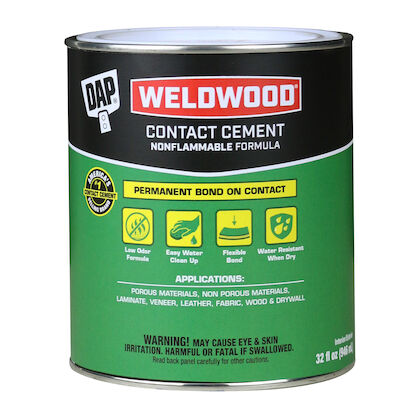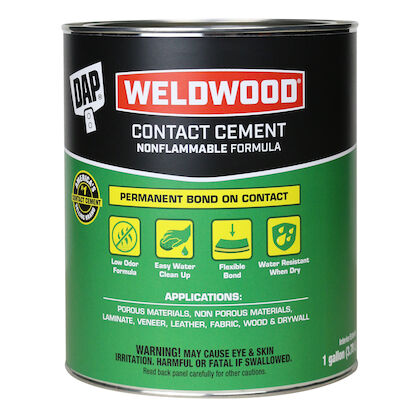To clean contact cement, use a solvent such as acetone or a specialized adhesive remover, applying it to a rag and gently wiping the affected area. Direct contact with the adhesive spot should dissolve the bond, facilitating easy removal.
Contact cement is known for its robust adhesive quality, making it a go-to solution for various DIY projects and repairs. Yet, despite its strength, there are times when this sticky substance finds its way onto surfaces unintentionally. Homeowners and crafters alike often face the challenge of removing this tenacious material without causing damage.
Tackling this task requires a careful approach, using appropriate solvents that break down the adhesive properties of contact cement. Safety is paramount; it’s imperative to work in a well-ventilated space and to wear protective gear, such as gloves and goggles, to prevent irritation or harm from the potentially harsh chemicals. A succinct guide on the removal process not only serves the immediate need but also enriches the reader’s knowledge for future encounters with adhesive mishaps.
Introduction To Contact Cement
Contact cement is a popular adhesive known for its strong, instant bond. It’s unique because it sets quickly and requires no clamping. This adhesive becomes tacky in seconds, making it ideal for a range of projects.
Understanding Contact Cement
Understanding contact cement is crucial for its effective use. Unlike other glues, it requires applying to both surfaces. This adhesive works through a chemical reaction. Once the surfaces touch, they create an instant and durable bond.
Common Uses Of Contact Cement
Common uses of contact cement include:
- Attaching laminate to countertops
- Fixing shoe soles
- Adhering veneers to furniture
- Securing floor tiles
Why Cleaning Contact Cement Is Essential
Cleaning contact cement is essential to maintain surfaces. It ensures smooth application for new projects. Residue can create bumps and imperfections. Consequently, removing old cement prevents damage to surfaces for future projects.

Credit: www.dap.com
Pre-cleaning Considerations
Before tackling the sticky residue of contact cement, it’s vital to set the stage for a clean removal. Consider the type, safety, and proper solvents to ensure a successful clean-up. A thoughtful approach safeguards both surfaces and handlers.
Identifying The Type Of Contact Cement
Knowing the cement variety is crucial—it guides your solvent choice. Common types include neoprene and urethane-based cements. Neoprene is common in household repairs, while urethane is tougher and used in construction. Check the product label or reach out to the manufacturer.
Safety Precautions And Protective Gear
Cleaning involves chemicals, so safety first. Ensure good ventilation, don protective gloves and goggles, and keep flames away. Long sleeves and pants shield skin. Safety can’t be overstated when dealing with solvents.
Selecting The Appropriate Solvent
Choose a solvent that’s made to dissolve your contact cement. For neoprene-based cement, use acetone or commercial adhesive removers. Urethane cement might need a specialized urethane adhesive remover. Test the solvent on a hidden area first to prevent damage.
Methods For Cleaning Wet Contact Cement
Removing wet contact cement needs quick action. The right method ensures no damage. We’ll explore safe techniques. Get ready to tackle this sticky situation.
Using A Scraper Or Putty Knife
Tools matter when scraping away cement.
- Grab a scraper or putty knife.
- Apply gentle pressure to the wet cement.
- Slide the tool under the adhesive.
- Peel away the cement carefully.
Be cautious to avoid surface scratches.
Applying Solvents And Cleaners
Special cleaners soften cement.
- Choose a proper solvent or cleaner.
- Test a small, hidden area first.
- Apply the cleaner as directed.
- Let it sit to break down the bond.
- Use as instructed for safety.
Always check compatibility.
Wiping And Removing Residue
Removing leftover residue requires attention.
Follow these steps:
- Dampen a cloth with cleaner.
- Gently wipe the softened cement.
- Rinse the surface with water.
- Dry the area completely.

Credit: www.dap.com
Techniques For Removing Dried Contact Cement
Techniques for Removing Dried Contact Cement can be challenging once it has cured. Different approaches may be necessary depending on the surface and the amount of cement. Below are effective methods to tackle this sticky problem.
Mechanical Removal Methods
Mechanical methods prioritize physical labor without chemicals.
- Scraping: Use a putty knife gently to avoid surface damage.
- Sanding: A Sandpaper can smooth out residue on wood.
- Grinding Tools: Use with care on harder surfaces.
Chemical Removal Techniques
Chemicals can dissolve the bond contact cement creates.
- Acetone: Apply with a cloth and rub the spot.
- Adhesive Remover: Follow the product’s instructions strictly.
- Epoxy Solvents: Ideal for stubborn cement patches.
Heat Application To Soften Cement
Apply gentle heat to soften the cement for easier removal.
- Heat Gun: Use on a low setting and keep it moving.
- Iron: Place a cloth between the iron and the surface.
- Hot Water: Soak small items for 10-15 minutes.
Post-cleaning Procedures
Cleaning up after using contact cement is crucial for maintaining a safe and efficient workspace. Whether you’re wrapping up a craft project or a full-scale construction job, the right post-cleaning procedures ensure longevity for your tools and a clean area for future work.
Cleaning And Care For Tools Used
Clean tools are happy tools! Keeping your brushes, rollers, and spreaders free from hardened cement extends their life.
- Soak tools in a solvent that suits the adhesive type.
- Use a scraper to remove softened cement.
- Rinse tools with warm water.
- Dry thoroughly before storing.
Disposing Of Contact Cement Wastes
Responsible disposal protects the environment. Follow these steps:
- Never pour leftover cement down the drain.
- Allow small amounts to fully cure and throw in the trash.
- Check local regulations for solvent disposal.
Surface Preparation For Reapplication
Ready for the next layer? A clean surface ensures strong adhesion.
- Scrape off old cement carefully.
- Use a solvent to wipe away residue.
- Let it dry completely.
Prep right, stick tight! With these tips, you’re set to go again with a fresh, clean surface.
Tips And Tricks For Effective Cleaning
Cleaning contact cement from surfaces requires patience and the right approach. Knowing the best methods ensures the job gets done effectively and efficiently. Below are curated tips and tricks for tackling contact cement messes with ease.
Homemade Solutions Vs Commercial Products
The choice of cleaner plays a significant role in the success of cement removal. Determine the best cleaners for your needs below:
- Homemade Solutions: Gentle and eco-friendly options like a mixture of vinegar and water can attend to minor residues. These are safe for most surfaces and hands.
- Commercial Products: Stronger solvents like acetone are available for tough, dried cement. Wear gloves and ensure ventilation with these potent chemicals.
Preventing Future Spills And Accidents
Avoid future messes by taking preventive measures:
| Strategy | Description |
|---|---|
| Preparation Area | Designate a specific area for glue-related tasks to contain potential spills. |
| Protective Layer | Use a newspaper or plastic sheeting under your work to catch drips. |
| Tool Maintenance | Clean applicators promptly after use to prevent dried cement accumulation. |
Maintaining A Clean And Organized Workspace
An orderly workspace ensures cleanliness and efficiency. Adopt these habits:
- Store contact cement in sealed containers away from heat and direct sunlight.
- Immediately clean any spills with a cloth dampened with a suitable solvent.
- Organize tools and materials in designated areas to minimize clutter.

Credit: magpow.en.made-in-china.com
Frequently Asked Questions on How To Clean Contact Cement
What Is The Best Solvent To Remove Contact Cement?
Acetone often serves as the best solvent for dissolving contact cement due to its strength and effectiveness. Always use it in a well-ventilated area and follow safety precautions.
Does Acetone Clean Contact Cement?
Yes, acetone can effectively clean contact cement due to its strong solvent properties. It dissolves the adhesive for easy removal. Use with caution and ventilation.
Does Rubbing Alcohol Remove Contact Cement?
Yes, rubbing alcohol can dissolve contact cement, making it easier to remove. Apply it directly to the adhesive and gently scrub.
What Can I Use To Clean Contact Adhesive?
To clean contact adhesive, use acetone or a specialized adhesive remover. Apply the solvent with a cloth and scrub gently until the adhesive dissolves. Rinse the area with water after cleaning.
Conclusion
Cleaning contact cement requires patience and the right approach. Start with gentle methods, then escalate as needed. Remember, safety and surface preservation are key. For stubborn residue, consider commercial removers. Maintaining a well-ventilated area is crucial during this process. It’s time to enjoy your spotless surfaces – your diligence will pay off!
As an Amazon Associate, Cleanestor earns from qualifying purchases at no additional cost to you.